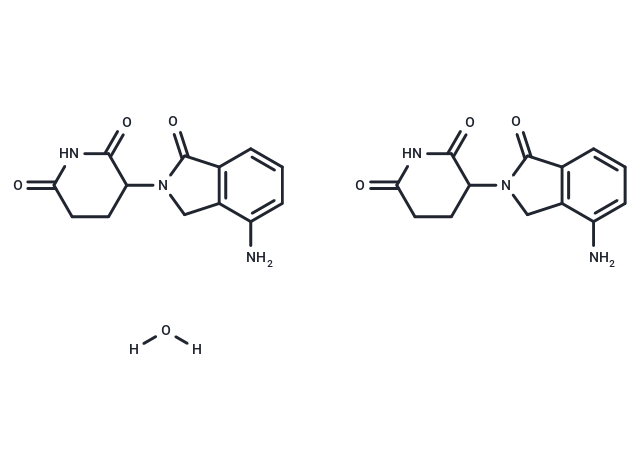Shopping Cart
- Remove All
 Your shopping cart is currently empty
Your shopping cart is currently empty

Lenalidomide hemihydrate is a derivative of Thalidomide, an orally active immunomodulator that acts as a molecular gel. It is a ligand for the ubiquitin E3 ligase cereblon, which selectively ubiquitinates and degrades two lymphoid transcription factors, IKZF1 and IKZF3, via the CRBN-CRL4 ubiquitin ligase.

| Pack Size | Price | Availability | Quantity |
|---|---|---|---|
| 25 mg | $29 | In Stock |
| Description | Lenalidomide hemihydrate is a derivative of Thalidomide, an orally active immunomodulator that acts as a molecular gel. It is a ligand for the ubiquitin E3 ligase cereblon, which selectively ubiquitinates and degrades two lymphoid transcription factors, IKZF1 and IKZF3, via the CRBN-CRL4 ubiquitin ligase. |
| Targets&IC50 | TNF-α:13 nM |
| In vitro | Lenalidomide inhibited autoubiquitination of CRBN in HEK293T cells expressing thalidomide-binding competent wild-type CRBN, but not thalidomide-binding defective CRBN(YW/AA). Overexpression of CRBN wild-type protein, but not CRBN(YW/AA) mutant protein, in KMS12 myeloma cells, amplified pomalidomide-mediated reductions in c-myc and IRF4 expression and increases in p21(WAF-1) expression. Long-term selection for lenalidomide resistance in H929 myeloma cell lines was accompanied by a reduction in CRBN, while in DF15R myeloma cells resistant to lenalidomide, CRBN protein was undetectable[1]. |
| In vivo | Range finding studies used lenalidomide concentrations up to 15 mg/kg IV, 22.5 mg/kg intraperitoneal injections (IP), and 45 mg/kg oral gavage (PO). Pharmacokinetic studies evaluated doses of 0.5, 1.5, 5, and 10 mg/kg IV and 0.5 and 10 mg/kg doses for IP and oral routes. Liquid chromatography-tandem mass spectrometry was used to quantify lenalidomide in plasma, brain, lung, liver, heart, kidney, spleen, and muscle. Pharmacokinetic parameters were estimated using noncompartmental and compartmental methods. Doses of 15 mg/kg IV, 22.5 mg/kg IP, and 45 mg/kg PO lenalidomide caused no observable toxicity up to 24 h postdose. We observed dose-dependent kinetics over the evaluated dosing range. Administration of 0.5 and 10 mg/kg resulted in systemic bioavailability ranges of 90-105% and 60-75% via IP and oral routes, respectively. Lenalidomide was detectable in the brain only after IV dosing of 5 and 10 mg/kg. Dose-dependent distribution was also observed in some tissues. High oral bioavailability of lenalidomide in mice is consistent with oral bioavailability in humans. Atypical lenalidomide tissue distribution was observed in spleen and brain[3]. |
| Molecular Weight | 268.28 |
| Formula | C13H13N3O3.1/2H2O |
| Cas No. | 847871-99-2 |
| Smiles | O=C(C(N(CC1=C2C=CC=C1N)C2=O)CC3)NC3=O.O=C(C(N(CC4=C5C=CC=C4N)C5=O)CC6)NC6=O.[H]O[H] |
| Relative Density. | no data available |
| Storage | Powder: -20°C for 3 years | In solvent: -80°C for 1 year | Shipping with blue ice. |
| Solubility Information | DMSO: Soluble |

Copyright © 2015-2025 TargetMol Chemicals Inc. All Rights Reserved.